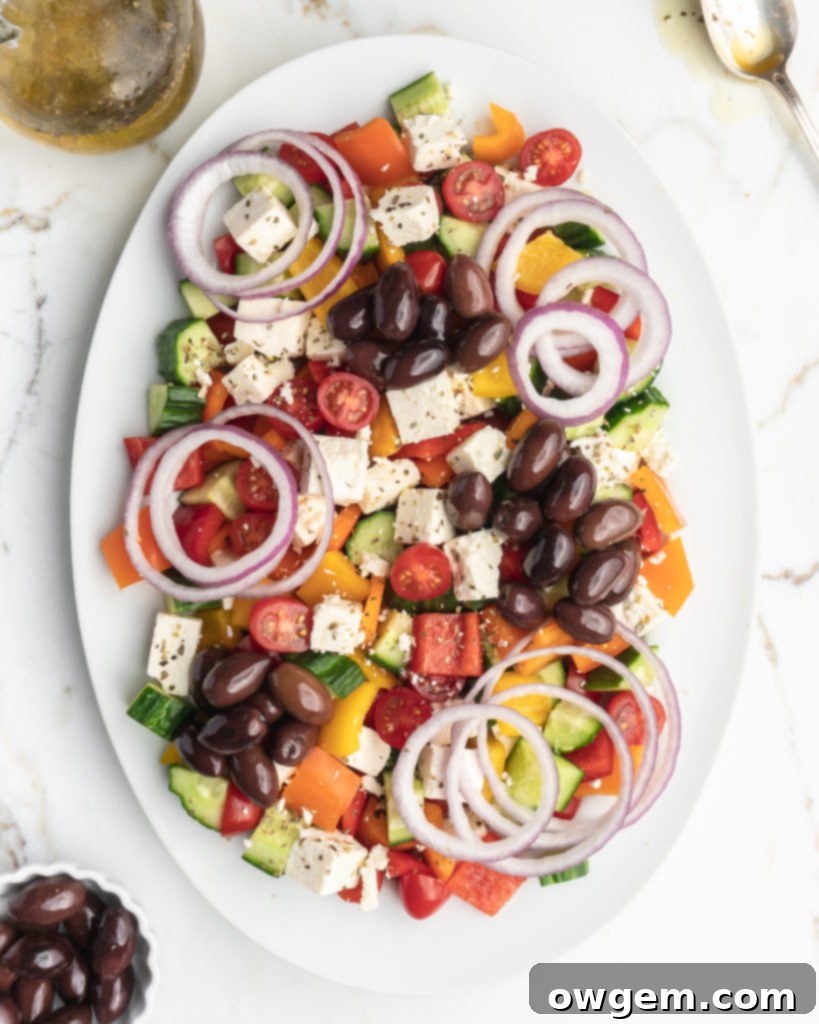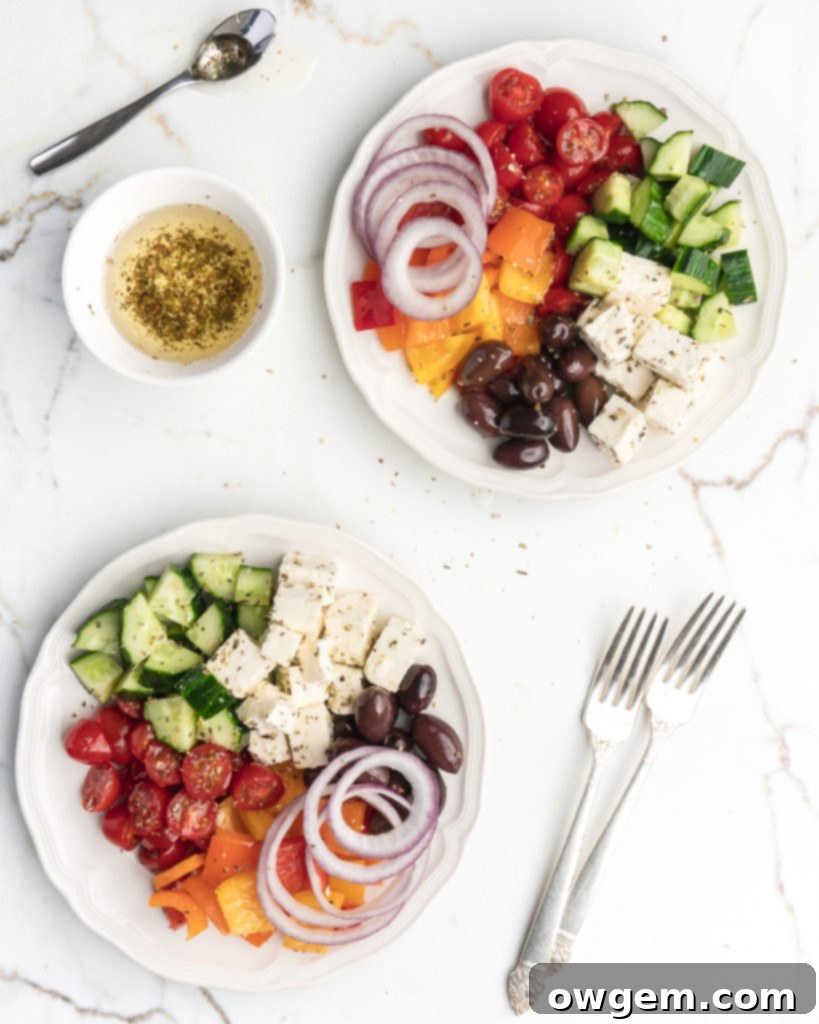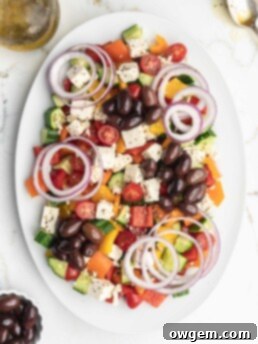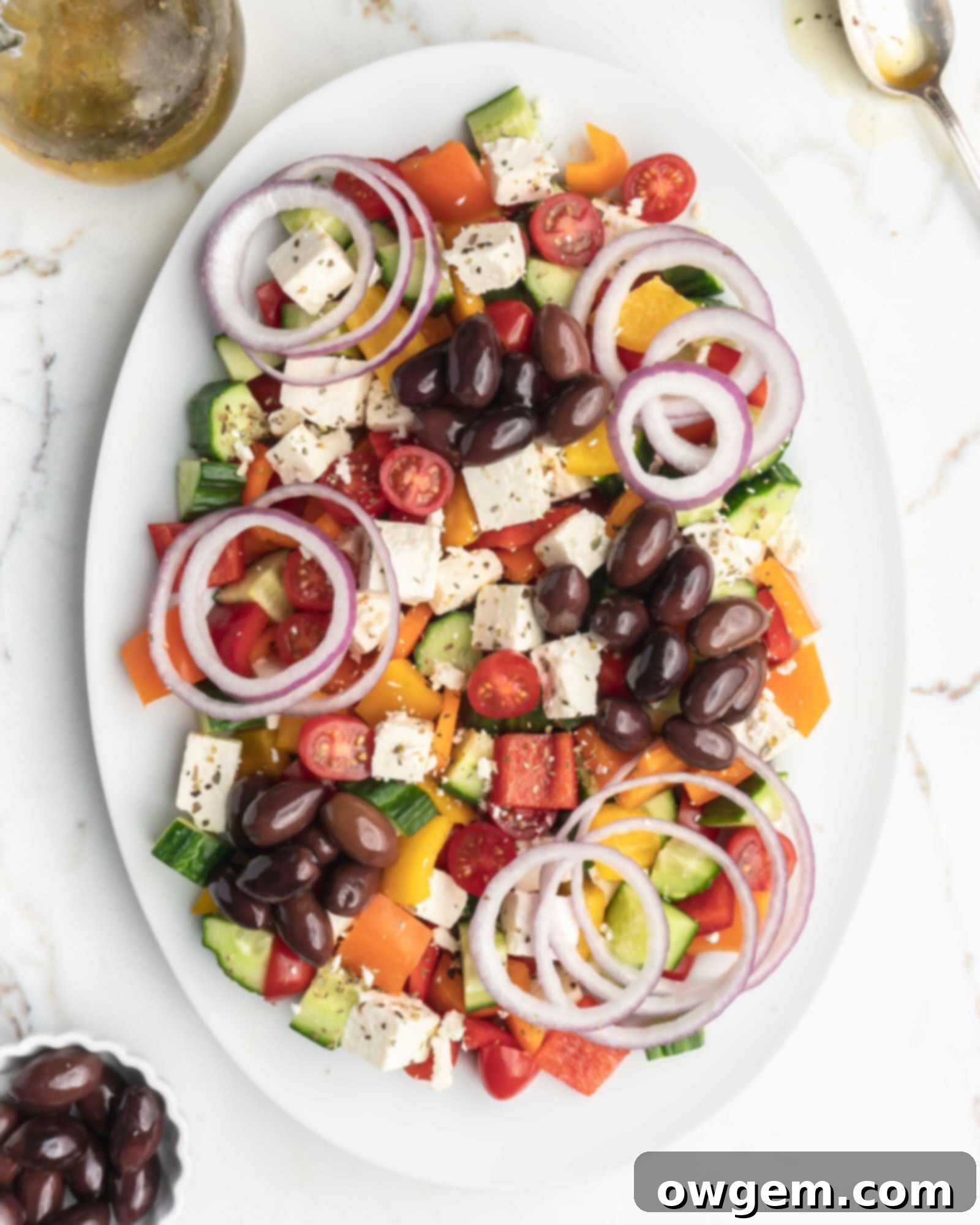Easy & Authentic Greek Salad with Homemade Dressing: Your New Go-To Side Dish
Discover the ultimate Easy Greek Salad recipe, featuring a vibrant medley of fresh vegetables, savory Kalamata olives, and tangy feta cheese, all brought together with a simple yet incredibly flavorful homemade dressing. This classic Mediterranean salad is more than just a side; it’s a celebration of fresh ingredients and robust flavors. Passed down from cherished family recipes, this Greek salad with its signature dressing will quickly become a staple in your culinary repertoire. Perfect for a light lunch, a refreshing side, or a stunning addition to any meal, its simplicity and taste are truly unmatched. Prepare to fall in love with its irresistible crunch and refreshing zest!

The Role of Red Onions: A Salad Essential
When it comes to crafting the perfect Greek salad, the choice of onion makes a significant difference. While there’s a vast world of onions out there – from pungent whites to versatile yellows and mild sweets – red onions truly shine in this fresh preparation. White onions, known for their sharpest flavor, are often reserved for dishes where a strong onion punch is desired. Yellow onions offer a good all-around onion flavor, robust but not overly aggressive, making them a kitchen workhorse for cooking.
However, red onions stand out for their ideal balance of mild sweetness and a distinctive crisp, crunchy texture that elevates any salad. Unlike their sweeter counterparts which can sometimes be too soft, red onions maintain their structural integrity, providing a delightful textural contrast against the softer vegetables. Beyond their culinary attributes, their striking purple-red hue adds an undeniable visual appeal, transforming a simple salad into a vibrant feast for the eyes. Their milder flavor also means they can be enjoyed raw without overpowering the other delicate ingredients, ensuring every bite of your Greek salad is perfectly balanced. For those sensitive to even mild onion bite, a quick soak in ice water for 10-15 minutes can further mellow their flavor, though many find this step unnecessary with quality red onions.

Unlocking the Fifth Taste: Why Umami Makes This Greek Salad Irresistible
Have you ever wondered what gives certain dishes that deep, satisfying, meaty, or savory richness that goes beyond salty or sweet? That, my friends, is umami – often referred to as the “fifth taste.” Alongside sweet, sour, salty, and bitter, umami adds a profound layer of depth and savory deliciousness that is difficult to achieve otherwise. It’s essentially the taste of glutamate, an amino acid detected by specialized receptors on our tongues. When these receptors are activated, they signal a truly satisfying, full-bodied flavor profile that enhances and complements other tastes in a dish.
Umami isn’t just a standalone flavor; its true power lies in its ability to amplify and harmonize other ingredients. This is precisely why compounds like MSG (monosodium glutamate) are used to enhance food – they are a sodium salt of glutamate. To truly unlock a food’s natural umami potential, it often requires cooking or fermentation, processes that release these amino acids, making them more available for our taste buds. This is evident in the stark difference between bland uncooked meat and richly savory cooked meat, or between mild milk and complex, flavorful fermented cheese.
What’s truly remarkable about umami is its synergistic effect. When you combine multiple ingredients high in umami, the flavor impact isn’t just additive; it’s exponential. As food writer Laura Santtini eloquently puts it, when it comes to umami, “1+1=8.” This means that distinct umami-rich foods, while delicious on their own, create an explosion of flavor when paired. She cites the example of tomatoes, beef, and Parmesan cheese – all individually high in umami. Combine them into a Bolognese sauce, and the resulting depth of flavor is truly mind-blowing, far greater than the sum of its parts. Umami intensifies saltiness and sweetness, while simultaneously balancing out sourness and bitterness, creating a perfectly rounded taste experience.
The relevance of umami to our Greek salad cannot be overstated. Two of its star ingredients, Kalamata olives and feta cheese, are powerhouses of natural umami. Olives, especially fermented ones like Kalamata, are exceptionally high in glutamates, contributing a deep, briny, and profoundly savory note. Feta cheese, a fermented dairy product, also boasts a significant umami profile, adding a salty, tangy, and complex richness. These ingredients, when combined with the fresh vegetables and the bright, acidic dressing, create a salad that is not only refreshing but also deeply satisfying and incredibly moreish, thanks to the harmonious interplay of umami flavors.

The Magic of Homemade Greek Salad Dressing
While the fresh, crisp vegetables and savory cheeses are the heart of any Greek salad, the dressing is undeniably its soul. A homemade dressing elevates this simple dish from good to extraordinary. Unlike many store-bought varieties that can be overly sweet, loaded with preservatives, or lack authentic flavor, a homemade dressing allows you to control the quality and balance of every ingredient. Our simple recipe, featuring quality extra virgin olive oil, balsamic vinegar, dried oregano, a touch of feta brine, salt, and pepper, emulsifies into a vibrant, tangy, and aromatic elixir that perfectly coats every component of the salad. The feta brine is a secret ingredient, adding an extra layer of salty, savory depth that ties the dressing directly to the cheese in the salad, creating a cohesive flavor profile that tastes truly authentic and incredibly fresh. It’s incredibly easy to whisk together, proving that the best flavors often come from the simplest preparations.
Ingredient Swaps and Customization Tips
While our classic Greek salad recipe is perfect as is, it’s also incredibly versatile and can be adapted to suit your personal preferences or what you have on hand. Here are a few popular variations and considerations for tailoring your salad:
- **Balsamic Vinegar Choices:** You have flexibility with your balsamic vinegar.
- **White Balsamic Vinegar:** Although technically not a “true” balsamic in the traditional sense, its flavor profile is similar to regular balsamic but with a milder, less sweet tang. It’s an excellent choice if you prefer a lighter-colored dressing that won’t stain the other ingredients, maintaining a bright aesthetic for your salad.
- **Traditional Dark Balsamic Vinegar:** This offers a slightly sweeter, more robust, and deeply complex flavor. It’s the more traditional choice and will yield a dressing with a darker hue, which some prefer for its classic appeal. Both options are delicious; choose based on your desired sweetness and visual preference.
- **Feta Cheese Selection:** The type of feta can significantly impact the salad’s flavor.
- **Goat Feta:** My personal preference, goat feta offers a more pungent, tangy, and earthy flavor profile. Its distinct brininess and creaminess add a layer of sophistication to the salad that I absolutely adore.
- **Cow Feta:** If you prefer a milder, less intense cheese flavor, cow’s milk feta is a fantastic alternative. It’s often creamier and less assertive, making it a great choice for those new to feta or who prefer a softer taste.
- **Sheep Feta:** This is the most traditional form of Greek feta, offering a rich, salty, and slightly crumbly texture with a balanced tang that sits beautifully between goat and cow varieties.
- **Tomato Considerations for Storage:** The recipe calls for cherry or grape tomatoes, which are ideal, but you can also use larger varieties.
- **Cherry/Grape Tomatoes:** These are excellent for their sweetness, firm texture, and ease of preparation. When sliced, they release some juice, but their smaller size helps minimize excessive wateriness.
- **Roma/Plum Tomatoes:** While perfectly acceptable for flavor, they tend to be juicier. The salt in the dressing will draw out their moisture, potentially making leftover salad watery. If you anticipate leftovers, it’s best to add sliced Roma tomatoes just before serving, or store them separately.
- **Whole Tomatoes for Leftovers:** To prevent a watery salad when making ahead or expecting leftovers, I strongly recommend leaving cherry or grape tomatoes whole. This keeps their juices contained, ensuring your salad remains crisp and fresh even after refrigeration.
- **Balsamic Reduction Drizzle (Optional but Recommended):** For an added touch of gourmet elegance and balanced sweetness, a drizzle of balsamic reduction is a wonderful addition. I typically purchase pre-made balsamic reduction from the grocery store for convenience. A small amount drizzled over the plated salad just before serving not only enhances the aesthetic but also introduces a subtle, sweet counterpoint to the savory and tangy flavors, elevating the entire dish.
- **Adding Fresh Herbs:** Consider tossing in fresh parsley, mint, or dill for an extra burst of herbaceous freshness.
- **Protein Boost:** For a more substantial meal, grilled chicken, shrimp, or chickpeas can be excellent additions.
Serving Suggestions and Why This Salad Shines
This Easy Greek Salad is incredibly versatile and makes a perfect companion to a wide array of dishes. It shines as a refreshing side alongside grilled meats like chicken souvlaki or lamb chops, complementing their rich flavors with its bright acidity. It also pairs beautifully with baked fish or shrimp, offering a light and healthy contrast. For a vegetarian meal, serve it with warm pita bread and a generous dollop of hummus, or alongside a hearty lentil soup. Its vibrant colors and refreshing taste make it an ideal choice for summer barbecues, potlucks, or any occasion where you want to impress with minimal effort.
Beyond its incredible taste and versatility, this Greek salad offers significant health benefits. It’s packed with fresh vegetables, providing essential vitamins, minerals, and fiber. The healthy fats from the olive oil and the probiotics from fermented feta contribute to a well-rounded, nutritious meal. This salad embodies the essence of Mediterranean cuisine – simple, fresh, and wholesome ingredients that are as good for you as they are delicious. It’s more than just a salad; it’s a testament to the power of fresh ingredients and thoughtful flavor combinations, guaranteeing a delicious and satisfying experience every time.

Get the Recipe:
Greek Salad with Homemade Dressing
Pin
Rate
Ingredients
Greek Salad
- 2 Bell Peppers (Red, Orange, Yellow),, washed, de-seeded, and coarsely chopped
- 1 English Cucumber, , washed and sliced into rounds and then quartered
- 1 cup Cherry or Grape Tomatoes, , washed, and left whole or sliced in half
- 1/2 Small Red Onion,, peeled and sliced into strips
- 1 cup Chopped Feta Cheese
- 1 cup Kalamata Olives,, whole or pitted
- Greek Salad Dressing (Below)
- (Optional) Drizzling of Balsamic Reduction
Greek Salad Dressing
- 4 tbsp Quality Extra Virgin Olive Oil
- 4 tbsp Quality Balsamic Vinegar,, white or traditional
- 2 tsp Dried Oregano
- 1 tsp Feta Brine
- 1/2 tsp Kosher Salt
- 1/4 tsp Freshly Ground Black Pepper
Instructions
Greek Salad
-
Add all the vegetables, feta, and olives to a large bowl. Add the salad dressing, then toss to combine.
(Optional) Drizzle top with balsamic reduction.
Greek Salad Dressing
-
Add all the ingredients to a medium sized bowl. Using a whisk, mix all the ingredients together vigorously until they are well emulsified.
-
(Optional) For easy emulsifying, add all salad dressing ingredients to a jar with a lid. Place lid on jar and shake vigorously.
